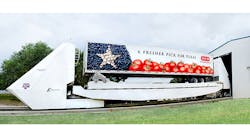Texas A&M Transportation Institute’s Freight Shuttle System (FSS) was debuted on Sept. 9. The system will move truck trailers and containers through congest ports and border crossing.
The FSS allows cargo to travel on elevated platforms at sea ports, border crossings and other heavily congested areas in order to expand shipping capacity, expedite trade and reduce congestion on highways.
Additionally, the FSS will enhance road safety, improve efficiency and significantly lower emissions and pollution.
The FSS is a project of Texas A&M Transportation Institute, private investors and the Port of Houston. It was conceived to resolve freight transportation’s most pressing deficiency: the lack of a system suitable for high-volume traffic between two points located less than 600 miles apart. This situation occurs frequently at marine ports, border crossings (land ports) and congested freight corridors.
By borrowing features from both heavy-duty diesel trucks and railroads, the FSS is economical for shorter distances and environmentally friendly. Much like trucks, the FSS’s transporters are autonomous: each transporter has its own motors and travels independently of other transporters. Inspired by railroads, FSS transporters use steel wheels to carry either a standard-size freight container or an over-the-road trailer. Moreover, the FSS runs on an elevated, dedicated right-of-way to avoid interference with and from other transportation systems.
However, unlike any other freight transportation mode, the FSS uses efficient, linear induction motors. Because these motors are electrically powered, the FSS will not add to existing pollution, will advance the United States’ effort to achieve energy independence and will allow more environmentally friendly energy choices. Moreover, by offering shippers and carriers a lower-cost option to over-the-road transport, the FSS directly reduces pollution, infrastructure damage and highway congestion, while improving traffic safety.
Freight Shuttle System Facts:
- At full capacity, can transport more than 300,000 tons of goods each day in each direction
- A single guideway can transport over 8,600 shipments each day
- Will use one-third of the energy used by heavy-duty diesel trucks at one-sixth of the cost
- Can move truck trailers and domestic intermodal containers up to 53 feet in size
- Transports shipments on elevated guideways for distances up to 500 miles




